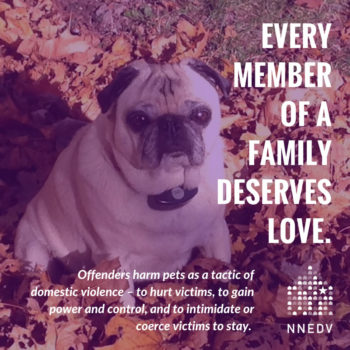Pets and Domestic Violence
November 23, 2016
Pets are often a key part of our families. We form strong emotional bonds with our companion animals and they provide friendship, laughs, and even sometimes headaches – like when they have chewed up a favorite sweater. For many of us, coming home for the holidays means embracing our much-loved and missed pets. At the National Network to End Domestic Violence (NNEDV), we believe that everyone should have a safe and peaceful holiday season – including our beloved pets.
Offenders harm pets as a tactic of domestic violence – to hurt victims, to gain power and control, and to intimidate or coerce victims to stay. In many cases, perpetrators of domestic violence may kill, harm, or threaten pets in order to assert their dominance and “emotionally blackmail” victims into complying with and remaining silent about the abuse victims are experiencing. [1] According to the American Society for the Prevention of Cruelty to Animals (ASPCA), seventy-one percent of pet-owning women entering domestic violence shelters reported that the abuser threatened, harmed, or killed the family pet. [2] Animal abuse can also be an indicator of domestic violence and is an early warning sign of concurrent or future violence. [3]

Victims of domestic violence may be reluctant to disclose abuse that they have experienced but may be more willing to seek help for their pets, which can open the door for ensuring their own safety and well-being. Neighbors are often more likely to report suspected animal abuse than domestic violence, making local humane societies and other animal protection professionals the first point of social services contact for some families in crisis. Once animal protective services become involved, they may recognize signs of domestic violence and have the opportunity to provide resources and referrals to victims. Increasing awareness of the link between domestic violence and animal abuse can provide an opportunity for collaboration between animal protective services and domestic violence programs. [1]
As many as one in four survivors have reported returning to an abusive partner out of concern for their pet. [2] In order to address this issue, some domestic violence programs are forging partnerships with animal welfare groups to find innovative solutions to keep survivors – and their pets – safe. [3] This can include modifying shelters to accommodate both survivors and their pets, so that survivors and their children can access safety without being separated from their pets. Likewise, many animal shelters allow survivors to have their pets fostered out to homes during their stay in the domestic violence program. This arrangement often allows victims to still visit their pet while they are accessing services. Increasing options for survivors and their pets is an important strategy toward increased safety.
Every home should be a safe home, and every member of a family should be able to live in peace and safety – including our furry friends. Until that day, NNEDV will work to create a social, political, and economic environment in which gender-based violence no longer exists.
—
[1] “Understanding the Link Between Violence to Animals and People” http://nationallinkcoalition.org/wp-content/uploads/2014/06/Allies-Link-Monograph-2014.pdf
[2] www.aspca.org/blog/protecting-all-victims-domestic-violence





